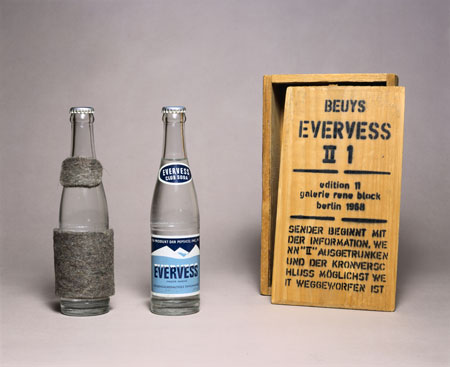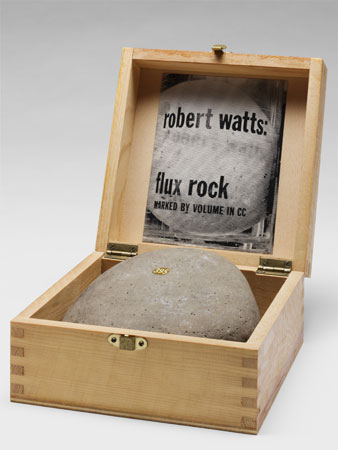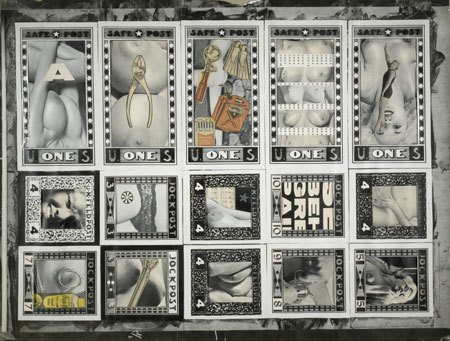Previous: A Voice Crying in the Wilderness (21)
Multiple Strategies at Busch-Reisinger
Post #967 • March 6, 2007, 2:47 PM • 18 Comments
Cambridge, MA—The contemporary art world owes much to Fluxus. Gavin Brown used its entire space at Art Basel/Miami Beach this past year to show a work by Urs Fischer, in which a crumpled package of cigarettes, by virtue of a length of monofilament attached to a motorized arm, was made to bobble about on the floor in an erratic circle. The cigarette package, as a non-art object in an art space, cited Duchamp's readymades. The motion, going endlessly counterclockwise for the sake of art, was pure Fluxus.
Multiple Strategies: Beuys, Maciunas, Fluxus, up at the Busch-Resinger through June 10, assembles objects and ephemera surrounding a movement that deserves more credit than it gets for Duchamp's influence on the rest of the century. After all, once Duchamp put forth his readymades (or rather, once the dealer Sidney Janis had some key readymades recreated over thirty years after the originals were discarded, and exhibited them), he went on to make assemblages. Except for some notable achievements such as the Large Glass, they mostly pale next to similar efforts by Joseph Cornell. The notions that art could be more fun, less serious, cheaper, communal, untied from drawing, and made to spread beyond the object itself and into the life surrounding it found full expression in the work of early Fluxus artists.
Unlike myriad contemporary objects done in similar spirits, these still have a whiff of radicalism on them. Some of their charm derives from a patina of age, like the one that old toys acquire. This charm insults their memory somewhat, as they were meant to look cheap and be cheap. A few of their makers, such as George Maciunas and Robert Watts, were decent graphic designers, and thus the signage and text incorporated into them have transformed over time into handsome typography examples. But something more challenging was meant when Beuys produced a series of wooden boxes with two bottles of water in each, with instructions to hurl one of them: the idea that life, spiced with a bit of chaos, could become as precious as art, and indistinguishable from it.
So what went wrong? Why is not anyone who chooses to do so living a life of unfettered, anarchic, creative freedom? I think back to Strunk & White's venerable The Elements of Style, in which E.B. White wrote:
In the end, Fluxus's two central pillars, art as a non-commodity, and art's infinite miscibility with life, were doomed projects that let loose hordes of uninspired instigators of banality.Spontaneous me,
sang Whitman, and, in his innocence, let loose the hordes of uninspired scribblers who would one day confuse spontaneity with genius.
Regarding the first, when a nihlist/Fluxus antecedent like the Fischer piece sells for $160,000, we can see that the non-art trappings of some objects have become their own art trappings. In the 1960s, when the bulk of this work was made, poor form was an assault on Brahmin taste. Now, it is its very marker. The Brahmins got the message that art didn't have to be skillful, beautiful, crafted, or even material, and a state-supported industry sprung up around the manufacture, sale, and philosophical defense of such art.
Regarding the second, a sane life is a pretty mundane affair, and a separate category called Art provides a meaningful place to cultivate objects meant only to delight us in some way. It turns out that is true even for people who supposedly delight in having their bourgeois tastes offended. One of Maciunas's works is a litle plastic box with a note inside saying, Close quickly.
It might enliven an especially conformist existence. With sufficient prior indoctrination, you might ponder whether you have become part of the artwork. (You haven't.) But as sure as you are destined for the grave, this little thing is destined for the vitrine, and there it lies under glass in the Busch-Reisinger, its radicalism spent, looking forlorn and disused, and mute except for a story about how once upon a time, some artists thought they had found the way to liberation.

Joseph Beuys (German, 1921-1986), Evervess II 1, 1968. Two bottles of soda water, felt, wooden box with printed cover, 27.7 x 16.5 x 9 cm, actual. Harvard University Art Museums, Busch-Reisinger Museum, The Willy and Charlotte Reber Collection, Edmée Busch Greenough Fund, 1995.214.A-D. Photo: Photographic Services © President and Fellows of Harvard College.

Various Artists (George Maciunas, editor and designer), Flux Year Box 2, late 1960s. Wooden box with title screen-printed on lid, containing numerous Fluxus editions, 20 x 20 x 8.5 cm. Harvard University Art Museums, Fogg Art Museum, Barbara and Peter Moore Fluxus Collection, Margaret Fisher Fund and gift of Barbara Moore/Bound & Unbound. Photo: Photographic Services © President and Fellows of Harvard College.

Robert Watts (American, 1923-1988), Flux Rock Marked by Volume in cc, c. 1964. Wooden box, printed label, rock with transfer-type lettering, 13 x 13 x 6.8 cm. Harvard University Art Museums, Fogg Art Museum, Barbara and Peter Moore Fluxus Collection, Margaret Fisher Fund and gift of Barbara Moore/Bound & Unbound. Photo: Photographic Services © President and Fellows of Harvard College.

Robert Watts (American, 1923-1988), SafePost/Jockpost/K.U.K. Feldpost, c. 1962. Collaged printer's mechanical, 42.5cm x 57.5cm. Maquette for sheet of stamps published as offset lithograph edition (2 examples in the collection). Harvard University Art Museums, Fogg Art Museum, Barbara and Peter Moore Fluxus Collection, Margaret Fisher Fund and gift of Barbara Moore/Bound & Unbound, M26495. Photo: Photographic Services © President and Fellows of Harvard College.
2.
March 6, 2007, 4:11 PM
These things don't just look dated and, frankly, quaint; they look like the sad detritus of what was only, at best, a case of people who, no matter how earnest, were just fooling themselves. It's hard enough to imagine anyone wanting to look at this stuff once, but twice is out of the question.
3.
March 6, 2007, 4:18 PM
It just came to me (no pun intended): intellectual masturbation (which does not necessarily imply being bright, let alone wise).
4.
March 6, 2007, 4:22 PM
That is very eloquent, and it is borne out all the more when we read a label like this beneath...
... some decidely non-cheap looking photographs of the work. That "Flux Year Box 2" photo is a particular beauty.
5.
March 6, 2007, 4:28 PM
This may be off-topic, but it's still germane. I was recently studying an engraving by Lucas van Leyden, The Return of the Prodigal Son. It was made in 1510, when he was 16. It was great then (at least Durer thought so, as did Rembrandt after him), and it's great now. The man died at age 39 or so, leaving about 200 prints and a couple of dozen modest paintings (now prized as some of the earliest genre paintings).
Where will these pitiful Fluxus trinkets and their makers be in 500 years?
6.
March 6, 2007, 9:14 PM
Don't mind if I do.
An interesting thing about Lucas van Leyden is that, while it is known he trained under two painters, nobody knows how or where he learned engraving, upon which his fame chiefly rests. However, at age 14, he was already capable of engraving fully worthy of a mature master (and yes, he got better as he got older). He developed new approaches to spatial (including landscape) and narrative construction. His graphic work is noted for the skill with which he designed and grouped companies of figures stationed on various planes of distance, and for his care in expressing the effect of aerial perspective. Less intellectual than Durer, he loved anecdotal and genre elements. He also had superb technical skills, and his patience and delicacy of hand are considered unsurpassed.
Now, I'm supposed to take seriously (let alone be impressed by) Beuys and his water-bottle nonsense (Ooooh! How anarchic!) or Maciuna's stupid little box? PLEASE. Get this litter out of my face.
7.
March 6, 2007, 9:15 PM
Jack I have often wondered, have we become a world that values trash over treasures ?
8.
March 6, 2007, 10:18 PM
The Return of the Prodigal Son In back, one world on the left, the other on the right
9.
March 6, 2007, 11:02 PM
Thanks, George. Not bad for a teenager, eh?
JM, trouble is, trash is now sold (and bought) like treasure, either because people can't tell the difference, or because they've become too degenerate to care.
10.
March 7, 2007, 12:10 AM
George, they are but the same.
11.
March 7, 2007, 9:00 AM
That image is very good. Was there trash back then too but we just see the weeded out treasure? To me the Fluxus stuff looks sad, like old hippies or disenchanted communists.
12.
March 7, 2007, 10:47 AM
Keep in mind that the image linked by George shows the effects of time on the paper of the print; the brownish discoloration would not have been there originally, meaning it would have looked cleaner, sharper and brighter.
There has always been trash, obviously, but I doubt it's ever been treated as treasure to the extent it is now. The problem is not so much that trash exists, since that's inevitable, but rather how it's judged or viewed.
13.
March 7, 2007, 10:56 AM
wwc, there has always been that 99% which has been forgotten, and then people forget in turn that it ever existed and think what we see in the museums is what was out there.
The difference today it there is so much more calling itself art than there ever was, and therefore so much more that is forgettable.
14.
March 7, 2007, 12:59 PM
Some artists are resourceful, either by choice or because they have no choice but to respond to the materials within their reach. Some more than others can make treasure out of trash. However, some art objects are meant to look trashy on purpose. This is where the art is supposed to be cool or good by being intentionally bad or sarcastic.
15.
March 17, 2007, 1:17 PM
it's not so much that these boxes are sad. The concept was a great one, the problem was that the execution of it was easily turned into exactly what they were railing against. Fluxus art was an attempt to make art accessable to everyone, to take the art off the canvas and put it in your mind, so that everyone could experience it and own it and see the beauty in the mundane. The biggest problem the Fluxus artist ran into is that no matter how much you may try, someone is going to collect all the little physical realities and stick them behind glass in a sad little parade. it's like Seeing the birds out in the wilderness and loving how free they look, so you capture them and stick them in a cage. It totally ruins the whole reason they exist...
Fluxus art is meant to be experienced, not collected.
16.
March 17, 2007, 1:17 PM
it's not so much that these boxes are sad. The concept was a great one, the problem was that the execution of it was easily turned into exactly what they were railing against. Fluxus art was an attempt to make art accessable to everyone, to take the art off the canvas and put it in your mind, so that everyone could experience it and own it and see the beauty in the mundane. The biggest problem the Fluxus artist ran into is that no matter how much you may try, someone is going to collect all the little physical realities and stick them behind glass in a sad little parade. it's like Seeing the birds out in the wilderness and loving how free they look, so you capture them and stick them in a cage. It totally ruins the whole reason they exist...
Fluxus art is meant to be experienced, not collected.
17.
March 18, 2007, 10:33 AM
Actually, "The biggest problem the Fluxus artist ran into" was being a movement based on such misguided, dubious premises (as twice stated above) to begin with, along with not being able to overcome such limiting misconceptions through the making of good quality art.
18.
March 20, 2007, 9:27 AM
If I do something wrong please let me know!
[Okay. You're doing something wrong.]
why people do this
[Because your head is full of shit. - F.]
1.
opie
March 6, 2007, 3:16 PM
" But as sure as you are destined for the grave, this little thing is destined for the vitrine, and there it lies under glass in the Busch-Reisinger, its radicalism spent, looking forlorn and disused, and mute except for a story about how once upon a time, some artists thought they had found the way to liberation."
That is very eloquent, and it is borne out all the more when we read a label like this beneath:
Various Artists (George Maciunas, editor and designer), Flux Year Box 2, late 1960s. Wooden box with title screen-printed on lid, containing numerous Fluxus editions, 20 x 20 x 8.5 cm. Harvard University Art Museums, Fogg Art Museum, Barbara and Peter Moore Fluxus Collection, Margaret Fisher Fund and gift of Barbara Moore/Bound & Unbound, M26448. Photo: Photographic Services © President and Fellows of Harvard College.